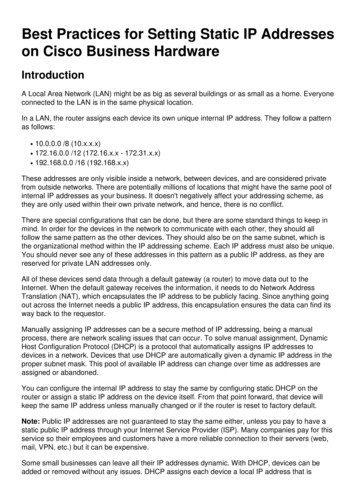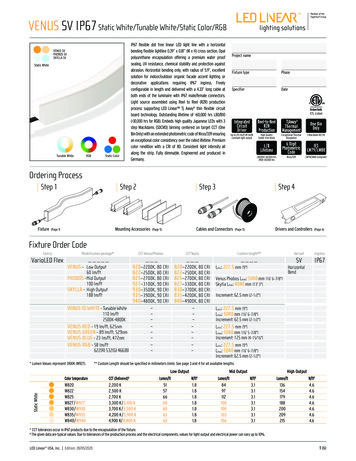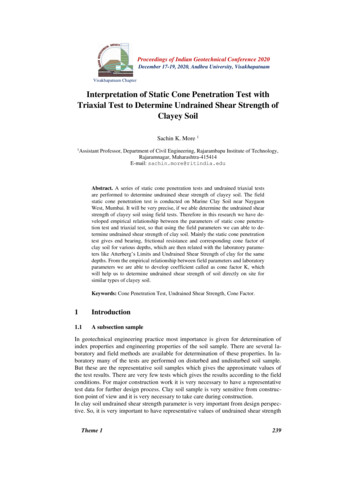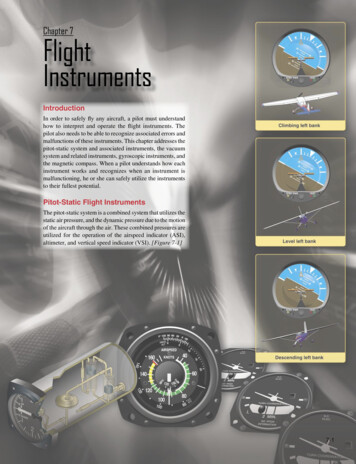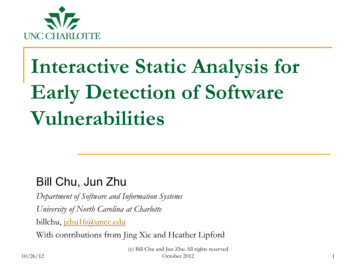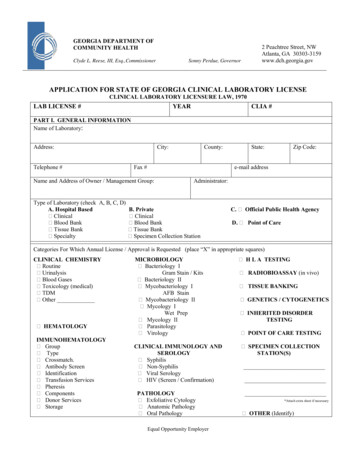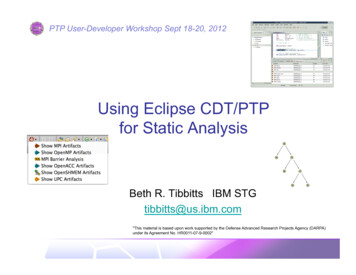
Transcription
MAE 334 09Lab 1Department of Mechanical and Aerospace EngineeringMAE 334 - Introduction to Instrumentation and ComputersLaboratory 1Static and Dynamic Calibration of ThermocouplesObjectivesThis introductory experiment will give you a first experience in ourInstrumentation and Systems Lab. You can expect to become familiar with the most basicconcepts of using transducers for measurement and the acquisition of data with acomputer based data acquisition system. You will use the National Instrument’s softwareproduct called Virtual Bench which is a part of the LabView data acquisition package.Data is gathered through an analog to digital converter (ADC) which is also a NationalInstrument’s product. The data acquisition system will be reading the output voltages of atemperature sensor called a thermocouple which you will calibrate and use to estimateseveral water and air temperatures. Specifically, the objectives of the experiment are:(1)to become familiar with thermocouples as very common transducers formeasuring temperature;(2)to carry out a formal static calibration of a thermocouple as a typical transducer,in order to explore the linearity of a typical calibration curve and to evaluate theaccuracy of measurements that can be made using the calibration;(3)to perform a dynamic calibration of a thermocouple considering a first orderdynamic model of its transient behavior and to explore the factors which influencethe dynamic response of thermocouples.BackgroundThermocouples are probably the most widely used industrial and laboratorytemperature sensor because they are simple, relatively inexpensive, and reasonablylinear. The thermocouple outputs a small electromotive force (emf or voltage) which isproportional to the temperature difference between the two junctions of the sensor. Thissmall voltage can be readily conditioned and sampled by a data acquisition system. ThePage 1 of 15
MAE 334 09Lab 1Figure 1. The lab setup showing the thermocouples, thermometer and dataacquisition inputs on the rightphysical phenomenon which creates the voltage produced by the thermocouple is referredto as the Seebeck effect – where a voltage is produced when two dissimilar materials areconnected together at junctions which are at different temperatures. See your text1 fordetails (Section 7.5 or 8.5 depending on the edition). You will also want to read over thematerial in our “Further Background” section at the end of this write-up.The equipment used in this experiment includes an accurate dial thermometer, acommercial thermocouple probe and a simple “homemade” thermocouple of copper andconstantan. You will use the digital multimeter (DMM) and the data logger of NationalInstrument’s Virtual Bench. There is also a collection of Styrofoam cups for you to use inproviding multiple temperature sources for your calibrations and transient experiments.Figure 1 shows a typical lab station.Getting StartedStart the PC operations by logging in with your user name and password. Ofcourse, if the PC is powered off, turn it on first. After you have logged in, you should findthat your Engineering home directory maps as drive N on the laboratory PC. You willwant to save your data here at the end of your lab sessions. You can also use the “My1Figliola, R. S., Beasley, D. E., Theory and Design for Mechanical Measurements, John Wiley, NewYork.Page 2 of 15
MAE 334 09Lab 1Documents” folder on the PC during your lab which will normally store directly into yourEngineering home directory. You can use the “Temp” directory on the laboratorycomputers for temporary storage but don’t rely on it as being a permanent storage spacefor you from lab to lab. USB flash disks are ideal to carry your data home or to othercomputers. Always make sure you have backed up your data files. Some of our saddestexperiences are with students losing data. Also, don’t forget to Logoff when you havefinished your lab session to close your login (and access to your account).Part 1 – Static CalibrationSetting Up the Virtual Bench DMM for Thermocouple MeasurementsPlace the dial thermometer on top of the aluminum input box for the analog todigital converter (ADC). This is to estimate the reference junction temperaturewhich is approximately the lab air temperature.Note the thermocouple probe and ADC cable connections. The thermocoupleprobe should be connected to ADC input channel 0 and a ground connectionshould be in place between the digital output ground and the ADC input ground ofchannel 0. Please note that the “first” input channel is usually referred to aschannel zero (this makes sense in a computer world). But sometimes the firstchannel is also referred to as channel 1. This may seem confusing but it is acontinuing issue so you should just “get used to it”.Click on the desktop icon for the VirtualBench. Then look for the VirtualBenchDMM (Digital Multi-Meter) in the options window that opens. Click on this andwhen the DMM opens click on Edit, Settings, General Tab. Set the Channel to 0and the Sample Rate to Slow. See Figure 2.Figure 2. The DMM General Settings WindowPage 3 of 15
MAE 334 09Lab 1Under the Edit, Settings, Temperature Tab (Figure 3), set the Temperature Sensorto "T Thermocouple" (for copper-constantan), the Temperature Units to "Celsius",the TC Cold Junction Source to "Constant" and the Cold Junction Temperature(Degrees) to your dial thermometer measurement. If your thermocouplemeasurements show obvious offset as you begin your calibration runs, thisJunction Temperature may be adjusted. Keep in mind that the ice bath is the verybest known temperature in this experiment and it’s always 0 C.In the main DMM window (Figure 4) set the Range to Auto, the Mode to VoltsDC and, when ready, click the Run Continuously button. The DMM is switchedover to a direct temperature reading mode by clicking on the thermometer icon asshown in Figure 5.Making the Temperature Measurements1. Obtain a supply of crushed ice and tap water including a cup of hot water.With the ice and hot and cold tap water, produce five cups with more or lessequally spaced water temperatures from 0 C to the temperature of the hottestwater (about 40 C). Be sure to stir the containers to ensure uniform temperaturesbefore recording any data. There should be plenty of ice in the ice water bath asyou take measurements and no ice in any other cup.2. Open an Excel spreadsheet to record your dial thermometer temperatures andthermocouple data. The data can then be immediately plotted to find bad orincorrectly entered data points and analyzed using a linear regression to obtain thecalibration slope and intercept. This calibration data must also appear in your labnotebook (calibration curves and linear regressions will be required for the labreport).3. Place the dial thermometer and the thermocouple probe in each cup of wateruntil the thermometer reading remains constant (approximately 30seconds). Gently tapping the dial thermometer may be helpful here. For eachpoint, record the thermometer temperature as well as the thermocouple voltageand the thermocouple temperature from the Virtual Bench Digital Multi-Meter(DMM). Detailed suggestions for gathering data are described directly below.Collecting the Static Calibration DataRecord the temperature of each of the five cups of water using the dialthermometer, the corresponding thermocouple probe voltage from the DMM, asin Figure 4, and the temperature output from the DMM, as in Figure 5. Sample thetemperatures in random order.Enter this data in an Excel spreadsheet, as in Figure 6, and in your lab notebookfor temperature measurement.Page 4 of 15
MAE 334 09Lab 1Figure 3. The DMM Temperature Settings WindowFigure 4. The VirtualBench-DMM main window in Volts DC mode.Note the mode setting (DC) and units displayed to the right of the digital outputFigure 5. The VirtualBench-DMM in Temperature ModePage 5 of 15
MAE 334 09Lab 1Figure 6. Example Excel spreadsheet used to record the static calibration dataRepeat the procedure above with your original water cups so that you have at least10 sets of data points obtained in this manner (you should take the temperature ofeach cup of water two separate times and record the DMM voltage andtemperature reading). Careful with microVolts and milliVolts.Refill your water cups to obtain a different set of temperatures for calibration.Repeat the process above with one pass through the refilled cups so that you havean additional five data points and a total of 15 data points for the calibration.Processing the Static CalibrationWe now assume that the dial thermometer provides an accurate measure oftemperature. The thermocouple probe is to be calibrated based on the dial thermometerreadings.We would like to generate two working calibration curves – the first one using thethermocouple voltage as measured by the DMM – this plots dial thermometertemperature (on the y axis) vs. thermocouple probe voltage (on the x axis). The secondworking calibration curve should use the thermocouple probe temperature as indicated bythe DMM. This curve should plot dial thermometer temperature (on the y axis) vs.thermocouple probe temperature (on the x axis). The two curves allow a choice formeasuring temperature with the thermocouple probe: (1) Read the voltage from thePage 6 of 15
MAE 334 09Lab 1DMM and use the curve to find the temperature. This is the traditional approach totemperature measurement. (2) Read the temperature value directly from the DMM (usingits built-in thermocouple calibration) and get a corrected result using the second curve.On your working calibration curves, make use of all of your fifteen data points.For each curve, show the linear trend line and its equation for the calibration data on theplot. For both calibrations, calculate the standard error (for the y axis) in your calibrationdata. You may use the Excel function LinEst to do this – free help from your TA.Part 2 – Dynamic CalibrationThe dynamic calibration will utilize the Virtual Bench Logger program of Figure7. The Virtual Bench Logger will sample the thermocouple voltage repeatedly after youspecify the desired sampling rate and total sampling time. The VBLogger is intended tooperate over longer time periods compared to “scope” type displays such as VBScope(which will be used in Experiment 2).Setting up the Virtual Bench LoggerExit the Virtual Bench-DMM. DO NOT INVOKE THE DIGITALMULTIMETER AND THE DATA LOGGER SIMULTANEOUSLY.THIS MAY LOCK-UP YOUR COMPUTERSelect the Logger from the Virtual Bench tool bar. Then select the Edit,Settings menu item to see the Logger Settings window of Figure 8. Set theStart Channel and End Channel to the lowest available channel. Typically thisFigure 7. The Virtual Bench-Logger programPage 7 of 15
MAE 334 09Lab 1Figure 8. Logger Setting Windowwill be 0-Ch0. But in some cases it may be 1-Ch1. This is a commonprogramming issue – is the first item in a list numbered “0” or numbered “1”?Set the Transducer to VDC and be sure that 50/60 Hz averaging is checked.Set the Range Max to 1.0E-3 and the Min to -1.0E-3 (i.e. plus or minus 1 mV).Also select 50/60 Hz averaging to minimize the effect of stray electrical noise.Next click the Timing Config button. This will allow you to adjust the Loggersampling rate and sampling time.In the Timing Configuration window of Figure 9, set the Time Interval (1/sampling rate), to 0.20 sec (this is compatible with the filtering selection).Set the Stop Timing entry to Stop After Elapsed Time of 30 seconds. Finally setthe Display Length to 30 seconds.Press OK. A Time Interval of 0.20 seconds results in a sampling frequency of 5samples per second. A 30 second data record will produce a 150 point data file(30 x 5 150).The final item to setup is the file configuration. This includes enabling theprogram to log the data to a file and specifies the file name. To accomplish thisclick the File Config button in the Logger Settings Window (Figure 8).In Figure 10, use the Browse button to locate an appropriate location (perhapsMyDocuments or c:\temp) and change the file name to something meaningful toyou (make sure to keep the .log extension).Page 8 of 15
MAE 334 09Lab 1Figure 9. Data Logger Timing Configuration WindowCheck the Enable Logging check box. Do not check the Begin Logging on Startbox.Note: After each data set is saved, the file name will need to be changedbefore logging starts again to avoid writing over previously saved data.Also, be aware of the Append/Overwrite option. Overwrite is preferred.Change the Field Length to 12 and the Precision to 9.Click OK to exit the File Configuration window.Click OK to exit the Logger Settings Window.To run the logger without saving data, just click the START button with theLogging Off check box setting. To log data (save to file) enable logging bychecking the Logging ON check box as shown in Figure 7. Then click the STARTbutton. The next 30 seconds of data (150 points at 0.20 second intervals) will belogged to the data file you specified.Collecting the Dynamic Calibration Data1. Immerse the thermocouple probe in the hot water for approximately 30 sec(required to reach an equilibrium state).2. Update the comments and file name in the Edit, Settings , File Config windowto reflect the contents of this step input data log (be sure logging is enabled).Page 9 of 15
MAE 334 09Lab 1Figure 10. Data Logger File Configuration Window3. Click the Logging On button (just to the left of the Clear and Start buttons)4. Click Start to begin data logging and then quickly move the thermocouple probefrom the hot water cup to the ice water cup. Expect a transient like Figure 7.5. Repeat steps 2 - 4, but now move the probe from a cool water cup (not ice) to theice water cup.6. Repeat steps 2 - 4 as appropriate to now create a step input from hot water toroom air. When you first expose the thermocouple probe to air, pull it through apaper towel as it leaves the hot bath to quickly dry it in order to minimize theeffect of evaporation. Log the data using the following new settings in the TimingConfiguration window: Time Interval 1 sec, Stop After Elapsed Time 10minutes, Display Length 10 minutes.That’s two ”water to water” step input data sets and one “water to air” step input data set.Processing the Dynamic Calibration DataThe dynamic calibration focuses on evaluating the time constant of the first ordermodel of the thermocouple probe’s dynamic behavior described by Equation (1) in theFurther Background section. Before proceeding into the dynamics, however, use yourstatic calibration linear equation to convert your three dynamic data sets from voltage totemperature. Plan to use Excel to create plots of temperature vs. time.For the first dynamic case in items 2 – 4 above (hot water to ice water), apply the“two thirds rule” illustrated in Figure 13 to estimate the time constant for the transientPage 10 of 15
MAE 334 09Lab 1temperature change. Use Equation (1) and Excel to simulate your first dynamictransient with your estimated time constant value. Plot your simulated response on thesame axes as the original data so that you can compare the modeled transient behavioragainst the actual transient. You may time shift the data as needed to adjust time “zero”.Normalized forms are often used to compare behaviors for conditions that are notexactly the same. Equation (2) uses the error function as a type of normalization. Use theleft hand side of Equation (2) to “normalize” your two water-to-water data sets (hot to iceand cool to ice). Using the left hand side of Equation (2), both of the transients shouldnow go from “one” to “zero”. Plot these two data sets on the same Excel graph so theycan be readily compared. This works easiest if you time shift the two data sets so thatboth temperature changes begin at time “zero”.Finally, use Excel to plot and study your water-to-air transient. Again apply the“two thirds rule” to estimate the time constant. Use your estimated time constant tosimulate the air transient. In a carefully labeled Excel plot, compare the simulationagainst your original data of temperature vs. time for water-to-air.Part 3 – Simple Thermocouple vs. the Thermocouple ProbeThe second channel on your ADC connection box includes a simple copperconstantan thermocouple. Set up the data logger to allow you to plot both channelssimultaneously (Start Channel 0-Ch0 and Stop Channel 1-Ch1). Apply the defaultthermocouple calibration by selecting the “Transducer” on both channels in the LoggerSettings to be a type T thermocouple with an appropriate constant reference temperature.Adjust the range in the Logger Settings to cover the range of cold and hot cuptemperatures in Celsius. Using the time range of thirty seconds with a 0.10 secondsampling interval will be adequate.Start with both the thermocouple probe and the simple thermocouple in the hotwater cup. Move them quickly from hot to ice, record the transients for both on the datalogger. Obtain a “print screen” of the combined transient for your report. Based on the“two thirds rule”, estimate the time constants for each thermocouple.Before You Leave the Lab have your teaching assistant check off your Excel spreadsheets showing your first draft ofthe plot for the calibration of thermocouple voltage (this will become ReportFigure 1).Also present your Excel plot for the air transient simulation (this will be ReportFigure 7).ReportIn your Summary, briefly describe your lab experiment and results. Be sure that yourResults section contains:1. The two working calibration Excel plots of part 1 showing the fifteen data pointsalong with trend lines and equations for the trend lines (ReportFigures 1 and 2).Discuss your LinEst results which show the standard error measures for the twoPage 11 of 15
MAE 334 09Lab 1cases. How do the LinEst results compare to the trend line calculations? Whatadditional information do you gain? Include one example clipping from Excel of yourLinEst calculations (ReportFigure 3).2. An Excel plot of the temperature vs. time data for your hot to ice water transient(ReportFigure 4) and your estimate of the simple time constant (2/3 rule) as adynamic calibration. Also show an Excel plot for the simulation with your estimatedtime constant from the 2/3 rule. On this plot, include the original data points alongwith the simulation (ReportFigure 5). The Excel plot comparing the two normalizedwater-to-water transient curves (ReportFigure 6). Calculation of the time constantestimate for the air transient. An Excel plot comparing the experimental data points tothe simulation for the air transient using the estimated time constant (ReportFigure 7).3. Your data logger results for the two channel transient comparing the dynamics of thethermocouple probe to the simple thermocouple (ReportFigure 8). Also your simpletime constant estimates for the two thermocouples.In the Discussion of Results indicate how successful you were in meeting theobjectives. How linear is the static calibration data? Based on your experience, is the firstorder dynamic model of Equation 1 adequate to describe the dynamic calibrationdata? From your two water-to-water step responses, does the time constant dependsignificantly on the size of the temperature step? Explain.Specific Questions1.Using your LinEst standard error results for the working calibration, what is yourestimate of the expected accuracy of thermocouple measurements made with thelaboratory thermocouple probe? Explain. Modify your Excel calibration plot ofReportFigure 2 by adding upper and lower error bound lines (adjusted by youraccuracy) to show your expected range of error (ReportFigure 9). Explain.2.For the calibration plot of the dial thermometer vs. the thermocouple probe usingthe DMM temperature display, what is the slope of the trend line? What is the yintercept? Which of these things is most influenced by the input of the constantreference temperature and why? Is the slope result as expected? Explain.3.Discuss the results of the thermocouple transient comparison for the thermocoupleprobe and the simple thermocouple. Why is there such a substantial difference?Cite any references that you use.4.Make a visit to the library or use the web to find an application of temperaturemeasurement using an electrical transducer. This should describe the use oftemperature sensing in an actual consumer or commercial product, not in aresearch study. Briefly discuss the application. Was a thermocouple chosen forthe application? Why or why not? Was dynamic response a consideration in theapplication? What company provided the transducer components?Page 12 of 15
MAE 334 09Lab 1Further BackgroundIn Figure 11, the simplest arrangement for a thermocouple temperaturemeasurement is shown and described. The thermocouple shown is measuring temperatureT1 while the connection to the voltage measurement device is at temperature T2. Figure12 shows another common configuration for thermocouple measurements using a knownconstant temperature reference (usually an ice bath) to control the temperature T2. Thisarrangement eliminates a junction of dissimilar metals at the voltage measurement deviceso that the generated voltage depends only on T1 and the well controlled referencetemperature T2.Use of a reference junction at a known temperature is cumbersome, particularlywhen temperatures at remote sites are to be monitored. An alternative is to use asecondary sensor, usually a semiconductor, and a compensation circuitry to correct forvariations in the reference junction temperature. See Figure 8.16 in the text (Figure 7.16in the 1st Edition). In our experiments, the thermocouple junction is “local” (in the lab onthe bench next to you) and the only temperature change experienced is that of thethermocouple itself. And so, for this simple situation, we are working withoutcompensation circuitry or a controlled reference junction. We do this for simplicity.However, a reference junction or compensation circuitry is normally recommended.Figure 11. Typical thermocouple as it would be attached to a measurement system.The first thermocouple junction is at T1, the second junction, made at the measuringdevice, is at T2. The voltage V1 produced depends on the temperature differencebetween T1 and T2. It is not affected by the temperature of the wires between thetwo junctions (T3).Page 13 of 15
MAE 334 09Lab 1Figure 12. A thermocouple circuit employing a constant temperature cold junction.The second junction, at temperature T2, is held at a constant known temperature(typically an ice bath). The voltage produced depends on the temperature differencebetween the ice bath and T1. Note that the junction at the measurement device nolonger contains dissimilar metals (wire type B is connected to both terminals) andtherefore does not effect the voltage as in Figure 11. With one junction held at aknown temperature, the voltage generated depends only on the temperature of theother junction.In this experiment, we use a simple linear calibration of the thermocouple to yielda slope and an offset, i.e. mx b. The offset is proportional to the temperature of theroom and thus if the room temperature changes, the thermocouple system should berecalibrated to remain accurate (the slope, indicated by m, would not change but theintercept, b, would). The advantage of a reference junction is that changes in the roomtemperature would not change the reference junction temperature and recalibration wouldnot be necessary.The thermocouple, like most temperature sensors, does not respondinstantaneously to changes in temperature. Since the thermocouple has a finite mass, heatmust be transferred to the thermocouple in order to raise its temperature. The timerequired to heat the sensor is determined by the heat transfer process, which is governedby the mass of the sensor, its specific heat and thermal conductivity, and the properties ofthe surrounding fluid. For typical thermocouple applications, a first order dynamic modeladequately describes the transient behavior. A relatively easy method to characterize theresponse of a first order system is to observe its response to a step change in input. Thestep response of first order systems is described in the section on “first order systems” inthe text. The first order transient response of a temperature T is described by:T (t )T(TTo )et/(1)where T(t) is the temperature as a function of time (the data you will record), T0 is theinitial temperature, T is the final temperature, t is time and τ is the time constant of thesystem.Page 14 of 15
MAE 334 09Lab 1Large Step Input ThermocoupleDynamic Calibration in Water90Temperature (C)80T(inf) 7570602/3 Step5040τ3050Temp DataSimulation 7 – 2 5 sec20T(0) 5100051015202530Time (sec)t(0) 2 secFigure 13. A typical dynamic response of a thermocouple subjected to a step inputtemperature change. In this graph, the initial temperature, T0, is approximately 5 Cand the final temperature, T , is approximately 75 C. The simulation was calculatedusing these parameters and Equation (1). Time, t, in Equation (1) was offset to startthe transient at 2 seconds (where the temperature change began).Or, rearranging into error function form,(TT (t )) /(TTo )et/(2)The term on the left hand size is referred to as the error function and varies between oneand zero.In your transient temperature studies with a step input in temperature, the data yourecord will have a shape similar to Figure 13 (perhaps showing falling temperatureinstead of rising). The curve in Figure 13 is the result of using Equation (1) to generatethe time response in Excel. In this case, the start of the simulated transient has beenshifted to occur at t 2 to agree with the start of the transient data. An alternative(probably more common) would be to adjust the transient data so that t 0 correspondsto both the start of the simulation and the start of the data.Page 15 of 15
calibration slope and intercept. This calibration data must also appear in your lab notebook (calibration curves and linear regressions will be required for the lab report). 3. Place the dial thermometer and the thermocouple probe in each cup of water until the thermometer reading remains constant (approximately 30 seconds).
